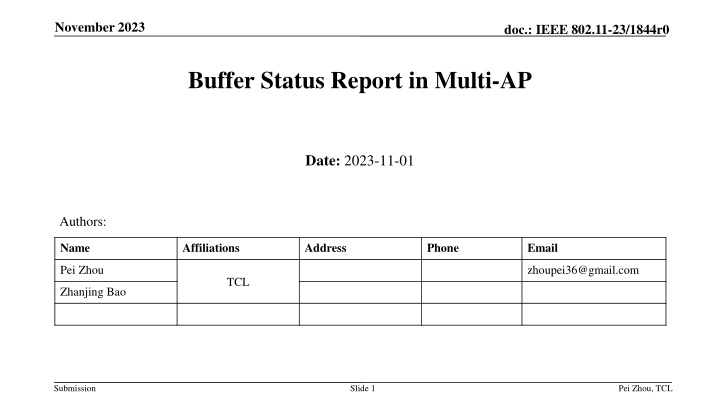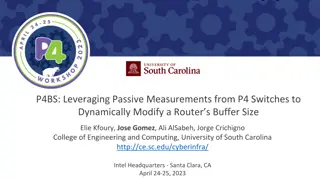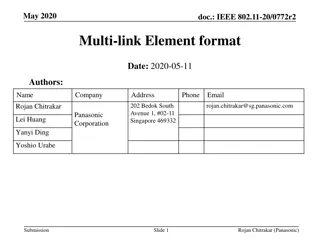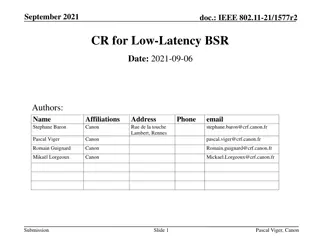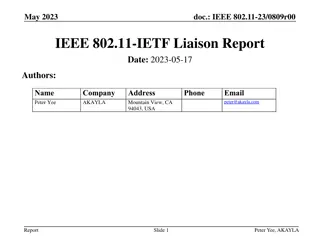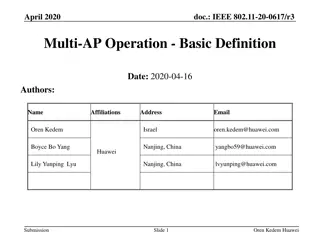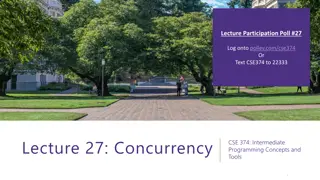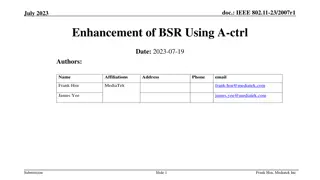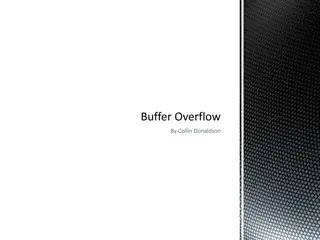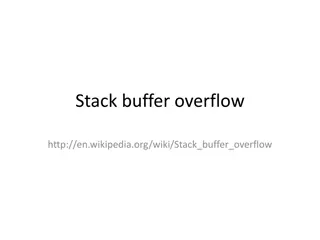IEEE 802.11-23/1844r0 Buffer Status Report in Multi-AP
In ultra-high rate networks, multi-AP coordination is essential for enhancing reliability and throughput. Various schemes like C-TDMA, C-OFDMA, C-SR are proposed to improve network performance. Efficient methods for obtaining resource needs and allocation among shared APs are discussed, aiming to optimize network latency, throughput, and fairness.
Download Presentation

Please find below an Image/Link to download the presentation.
The content on the website is provided AS IS for your information and personal use only. It may not be sold, licensed, or shared on other websites without obtaining consent from the author.If you encounter any issues during the download, it is possible that the publisher has removed the file from their server.
You are allowed to download the files provided on this website for personal or commercial use, subject to the condition that they are used lawfully. All files are the property of their respective owners.
The content on the website is provided AS IS for your information and personal use only. It may not be sold, licensed, or shared on other websites without obtaining consent from the author.
E N D
Presentation Transcript
November 2023 doc.: IEEE 802.11-23/1844r0 Buffer Status Report in Multi-AP Date: 2023-11-01 Authors: Name Affiliations Address Phone Email Pei Zhou zhoupei36@gmail.com TCL Zhanjing Bao Submission Slide 1 Pei Zhou, TCL
November 2023 doc.: IEEE 802.11-23/1844r0 Introduction In UHR, multi-AP coordination is considered as an important feature to increase not only throughput but also reliability UHR PAR [1]: Technical solutions to meet the needs of cutting edge applications should address both deployments with a single isolated BSS and deployments with multiple non-collocated BSSs in dense environments where in-band and optionally out-of-band (including via IEEE 802.3) AP coordination can be available (e.g., enterprise, residential). Currently, there are several multi-AP coordination schemes discussed in both 802.11be and UHR C-TDMA, C-OFDMA, C-SR, C-BF, J-TX, etc. [2] proposed a C-TDMA procedure by reusing the EHT TXS framework. The object is to enhance coordination among APs in time to improve the reliability of the network in latency, throughput and fairness Observation: Before TXOP sharing, the sharing AP needs to determine how much time allocate to shared AP(s). [3] proposed a Coordinated AP Time/Frequency Sharing procedure in 802.11be for worst case-latency improvement and throughput fairness SP #3: Define a mechanism for the TXOP owner AP to solicit feedback from the set of APs to learn the resource needs and the intent to participate in a coordinated AP transmission. Other multi-AP coordination schemes (C-SR [4], C-BF, J-TX, etc) may also need to know the resource needs in advance For example, the sharing AP may prioritize inviting the shared AP(s) with low latency traffic to perform C-SR, C-BF, J-TX, etc. Therefore, the precondition to perform multi-AP coordination is to obtain resource needs from shared APs. Submission Slide 2 Pei Zhou, TCL
November 2023 doc.: IEEE 802.11-23/1844r0 Possible methods for obtaining resource needs Sharing AP can use the following methods to obtain Shared APs resource needs, and then determine how much resource should be allocated to each Shared AP (e.g., for C-TDMA and C-OFDMA) or invite which shared AP(s) to participate in coordinated transmission. Method 1: Based on Shared AP s resource request Each Shared AP indicates its required resources (e.g., time duration, BW/RU) to Sharing AP Shared AP can actively include its required resources in an unsolicited frame Shared AP can include its required resources in a frame solicited by Sharing AP Sharing AP allocates required resources to each Shared AP Drawback: 1. If the total amount of resources requested by Shared APs exceeds what Sharing AP can provide, Sharing AP doesn t know how to execute the resource allocation 2. An arbitrary Shared AP may request more resources than needed, which will cause fairness issue to other Shared APs TXOP Duration TX Ind & Req Schedule Alloc CTI CTAS CTLS TXOP Owner (AP1) CTR CTLS AP2 CTR CTLS AP3 CTR CTLS AP4 CTI: CAP TXOP Indication frame CTR: CAP TXOP Requestframe CTAS: CAP TXOP AP Schedule frame CTLS: CAP TXOP LocalSchedule frame Example from [3] Method 2: Based on Shared AP s Buffer Status Report (BSR) Shared AP reports its BSR (with potential modifications) to Sharing AP Sharing AP evaluate all Shared APs BSR and determine the resource allocation In our opinion, method 2 is preferred to assist Sharing AP in multi-AP coordination. Submission Slide 3 Pei Zhou, TCL
November 2023 doc.: IEEE 802.11-23/1844r0 Re-cap: BSR in single BSS The non-AP STA can either implicitly deliver BSRs in the QoS Control field or BSR Control subfield of any frame transmitted to the AP (unsolicited BSR) or explicitly deliver BSRs in any frame sent to the AP in response to a BSRP Trigger frame (solicited BSR). [5] a) QoS Control field The buffer status reported in the QoS Control field consists of a queue size value for a given TID The Queue Size subfield indicates the amount of buffered traffic for a given TC or TS: at a non-AP non-HE STA sending the frame that contains this subfield, or at a non-AP HE STA for transmission to the HE STA identified by the receiver address of the frame that contains this subfield. The AP PS Buffer State subfield indicates the PS buffer state at the AP for a STA. b) BSR Control field The Control Information subfield in a BSR Control subfield contains buffer status information used for UL MU operation (see 26.5.2 (UL MU operation)). UL MU operation allows an AP to solicit simultaneous immediate response frames from one or more non-AP HE STAs. Observation: Currently, there is no BSR exchange procedure between APs (e.g., between Sharing AP and Shared APs). Submission Slide 4 Pei Zhou, TCL
November 2023 doc.: IEEE 802.11-23/1844r0 Proposal(s): C-BSR in UHR multi-AP In multi-AP coordination, if Sharing AP wants to allocate proper resource to proper Shared APs, the following enhancements may need to be made: Shared AP can report its C-BSR to Sharing AP by the following methods Unsolicited C-BSR Solicited C-BSR (by Sharing AP s BSRP Trigger frame) 1. (Shared) AP s C-BSR (Coordination BSR) should include the following Multiple (or all) associated non-AP STAs UL buffer status DL buffer status for multiple (or all) associated non-AP STAs Both of the above 2. Note: The detailed C-BSR format needs further study. Submission Slide 5 Pei Zhou, TCL
November 2023 doc.: IEEE 802.11-23/1844r0 Summary We highlighted the necessities to share C-BSR between APs in multi-AP coordination We proposed the methods to share C-BSR between APs Unsolicited C-BSR Solicited C-BSR We proposed the potential contents that need to be included into the C-BSR Multiple (or all) associated non-AP STAs UL buffer status DL buffer status for multiple (or all) associated non-AP STAs Submission Slide 6 Pei Zhou, TCL
November 2023 doc.: IEEE 802.11-23/1844r0 Straw Poll 1 Do you agree to add the following text to the TGbn SFD: TGbn shall define the method to share (Coordinated-)Buffer Status Report (C-BSR) between APs. Note: the detailed method is TBD. Y/N/A Submission Slide 7 Pei Zhou, TCL
November 2023 doc.: IEEE 802.11-23/1844r0 Straw Poll 2 Do you agree to add the following text to the TGbn SFD: Sharing AP can use one of more of the following methods to obtain the C-BSR of Shared AP: Unsolicited C-BSR Solicited C-BSR Note: the detailed methods are TBD. Y/N/A Submission Slide 8 Pei Zhou, TCL
November 2023 doc.: IEEE 802.11-23/1844r0 Straw Poll 3 Do you agree to add the following text to the TGbn SFD: The C-BSR of Shared AP may contain one or more of the following contents: Multiple associated non-AP STAs buffer status for the Shared AP Buffer status at the Shared AP for multiple associated non-AP STAs Note: the detailed C-BSR format is TBD. Y/N/A Submission Slide 9 Pei Zhou, TCL
November 2023 doc.: IEEE 802.11-23/1844r0 References [1] 11-23-0480-03-0uhr-uhr-proposed-par [2] 11-23-0041-00-0uhr-considerations-on-coordinated-tdma [3] 11-19-1582-02-00be-coordinated-ap-time-and-frequency-sharing-in-a-transmit-opportunity-in-11be [4] 11-23-1917-00-00bn-coordinated-spatial-reuse [5] Draft P802.11REVme_D4.1 Submission Slide 10 Pei Zhou, TCL
